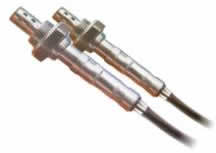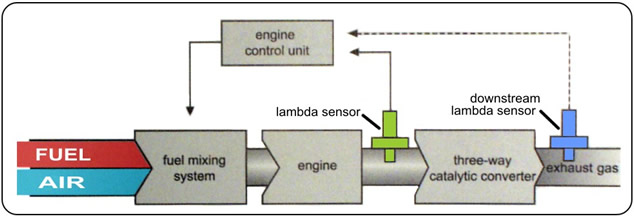 Page 1
Page 1
Introduction

Figure 1 - Lambda sensors
The lambda sensor is an electrical sensor mounted inside the exhaust system which can measure how well the combustion is occurring inside the engine. The amount of fuel allowed into the engine is controlled by the engine's fuel injection computer or ECU (Electronic Control Unit). The object of the sensor's operation is to allow the engine ECU to adjust the amount of fuel allowed into the engine for best economy and lowest emissions.
The sensor has to endure harsh conditions in hot exhaust gases, and in time it will wear out, just like other vehicle engine components wear out, such as spark plugs.
You may hear the Lambda Sensor referenced to by other names too, such as:
- EGO sensor - meaning 'Exhaust Gas Oxygen Sensor'
- HEGO sensor - meaning 'Heated Exhaust Gas Oxygen Sensor'. This refers to the heater element included within the 3-wire and 4-wire types.
- Oxygen sensor - referring to the fact that the Lambda Sensor measures the Oxygen present in the exhaust gas stream
- O2 sensor - back to school for this one - O2 is the chemical symbol for an Oxygen molecule. The number 2 reminds us that atoms of Oxygen like to go around in pairs
- Planar or 'Wideband' sensor - different to an ordinary Lambda, this is a more modern kind of sensor. It is fitted to engines that meet the latest emissions requirements.
- You may hear the word 'probe' substituted for 'sensor' - eg. Lambda Probe
- The word 'sonde' is common across mainland Europe - eg. Lambda Sonde
The sensor contains various precious metals, and can be contaminated by fuel or oil, carbon (a combustion by-product), or anti-freeze. If as a result of this contamination or of other internal problems the lambda sensor is worn out or damaged, the ECU will receive incorrect information from the sensor, and engine performance will suffer. Emissions of harmful gases from the exhaust will also increase.
Below is a block diagram of how the Lambda sensor fits into car's fuel system. The blue sensor represents a 'rear sensor', also known as a 'downstream sensor' or (in the States) a 'Sub-Oxygen' sensor. European vehicles got the rear sensor mostly only to vehicles made after the year 2000. Some Japanese vehicles have had rear sensors since 1990. This second lambda sensor gives the ECU an indication of how well the catalytic converter is working. These vehicles have 'OBD II'.
OBD stands for 'On Board Diagnostics'. In order to comply with the OBD II regulations, the ECU has to be able, amongst other things, to identify a failing catalytic convertor. It can do this by checking the signal received from the second sensor. There is a separate section with more on catalytic converters later.

Figure 2 - The Lambda Control Loop

